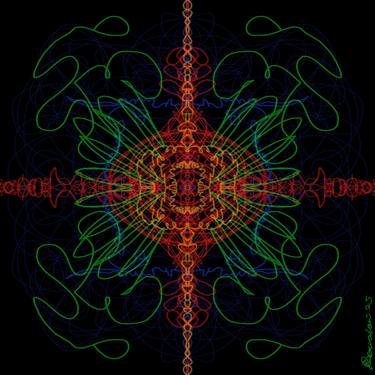Fashion! Art! Music! The home of Blink Friction a UK-based creative collective that merges sustainable fashion, collectible art, and rare books into a unique cultural experience. Founded by artist and musician Sarnia de la Maré FRSA, the brand champions eco-conscious design, artistic storytelling, and community engagement.
Showing posts with label podcasts. Show all posts
Showing posts with label podcasts. Show all posts
Apr 6, 2025
This week's trending podcasts by iServalan
Scanscore Review by iServalan™ phone photo to PDF to audio player is a life saver #genius
The new iServalan™ eBay project is super fun. Will my business succeed? Let's find out.
'We are at war' iServalan debates the state of the nation and the new world order
Music Lessons with iServalan™ practice tips and performance improvement
Learning to play the bass with iServalan™ tips for mapping the notes
Looking to buy a premises for a beauty and tattooing studio is my next little business venture
Donald Trump is such a dick coercive controlling bully who needs to go to jail
Blink Friction Interactive Digital Books By iServalan™ and snail slime cosmetics
Set up your own business selling bespoke personalised Rat Gang Crew Books by Sarnia de la Mare
The Beauty of Enharmonics for String Players and the Secrets they Hold #essays #musictheory
20 DEC 2024 · The Beauty of Enharmonic Notes on Stringed InstrumentsString players navigate a world rich with nuance and complexity, where a single pitch can have multiple interpretations. Enharmonic notes—tones that sound the same but are written differently (e.g., F# and Gb)—are a perfect example of this complexity. While on a keyboard or other tempered instruments these notes are identical, string players have the freedom to adjust intonation subtly. This ability allows them to choose whether a note leans towards its sharp or flat equivalent based on the musical context, style, and desired emotional effect.Differentiating Enharmonic Notes in ContextFor string players, the decision to play F# or Gb isn’t merely academic; it’s a matter of artistry. In classical music, a sharp note often carries a slightly brighter, upward-seeking quality, while a flat note can feel darker or more grounded. For instance, a violinist playing a romantic passage in a flat key might intonate a Gb with a touch more warmth than they would an F#.The style of music also plays a role. In Baroque and Renaissance music, string players often use just intonation to emphasize harmonic purity, resulting in subtle variations between enharmonic equivalents. In jazz and folk traditions, where expressive slides and microtonal inflections abound, the choice between a sharp or flat intonation might even defy conventional theory, instead serving the music’s emotional narrative.Modern styles add yet another layer of consideration. In genres like contemporary classical or experimental music, enharmonic flexibility becomes a tool for exploring unconventional tonalities and creating tension or release. String players are uniquely equipped for these subtleties, as their instruments allow for infinite gradations of pitch.The History of Music Notation and TemperamentThe concept of enharmonic notes is deeply tied to the history of music notation and the evolution of tuning systems. Early Western notation, influenced by vocal traditions, lacked the precise enharmonic distinctions we use today. Medieval theorists devised systems to document melodic intervals for vocalists, but it wasn’t until the Renaissance that composers began experimenting with chromaticism, requiring a more detailed system of notation.The rise of tempered instruments like the harpsichord and piano in the Baroque era brought enharmonic equivalence into sharper focus. Equal temperament—the division of the octave into 12 equal semitones—enabled composers to modulate freely between keys but erased some of the intonational nuances that vocalists and string players could achieve. Enharmonic notes on a piano became functionally identical, whereas on untempered instruments, they retained distinct identities.String players, unfettered by the fixed pitches of tempered tuning, continued to honor these differences. The violin family, for example, bridges the gap between the human voice and modern instruments, preserving the expressive potential of nuanced intonation.iServalan's Fascination with Strings and Universal VibrationsiServalan, a composer, cellist, and multi-instrumentalist, finds endless inspiration in the fluidity of stringed instruments. Her music explores the ancient and the futuristic, using the universal vibrations of strings to connect human experience to a greater cosmic rhythm. She sees every note—not just enharmonic pitches—as an opportunity for enlightenment, a way to align sound with the unseen forces of the universe.In both her art and music, iServalan delves into the concept of vibration as a unifying principle. Just as a string can produce infinite overtones, she believes music and art can generate layers of meaning, resonating deeply with those who experience it. Her fascination with the interplay of universal vibrations informs her compositions, blending traditional string techniques with electronic innovation, and creating immersive, multi-dimensional works that invite the listener to tune into the hidden harmonies of existence. Through this, she continues to explore the balance between precision and freedom, embodying the timeless allure of the stringed instrument. The Science of Tempered Instruments and the Freedom of String PlayersThe advent of tempered tuning in Western music was both a breakthrough and a compromise. Equal temperament divides the octave into 12 equal semitones, allowing instruments like the piano to modulate between keys seamlessly. This system is foundational for much of modern music, but it inherently sacrifices the pure harmonic relationships found in natural tuning systems. For string players, who are not bound by the rigid constraints of frets or keys, this compromise becomes an opportunity to reclaim the "real" vibrations of enharmonic notes.The Science of Equal TemperamentIn natural tuning systems, such as just intonation, the intervals between notes are based on simple frequency ratios, creating pure harmonies that resonate deeply with the human ear. For example, a perfect fifth in just intonation has a frequency ratio of 3:2, and a major third is 5:4. However, as music evolved to include more complex modulations, these systems proved limiting. A major third in one key might sound perfectly harmonious, but in another key, it could be slightly out of tune due to the differing interval relationships.Equal temperament solves this by "smoothing out" these discrepancies. In this system, all semitones are spaced equally, with a frequency ratio of the 12th root of 2 (~1.05946). This allows for consistent tuning across all keys but at the cost of natural harmonic purity. Enharmonic notes, like F# and Gb, become indistinguishable because their frequencies are mathematically identical in equal temperament, erasing the subtle differences that exist in non-tempered systems.String Players and the Quarter-Semiquaver AdjustmentString players, unlike pianists or guitarists, are not confined to the equal-tempered grid. They can adjust their intonation dynamically, often altering the pitch of an enharmonic note by as much as a quarter of a semitone—or even more—depending on the harmonic and melodic context.For example:F# in a melodic line: A violinist might intonate this note slightly sharper to give a sense of upward motion or brightness, aligning with the harmonic overtone series.Gb in a chord: The same player might play the note flatter to create a darker, more grounded resonance, blending naturally with the harmonic context of a flat-key piece.This flexibility allows string players to approximate the pure intervals of just intonation when playing in ensembles or solo contexts, creating a richer and more resonant sound. In a quartet, for instance, players often intonate chords using natural tuning to enhance harmonic clarity, even if the written music is in equal temperament.Real Vibrations and ResonanceThe key to understanding why string players adjust their tuning lies in the physics of vibration. Every note on a stringed instrument produces a fundamental frequency and a series of overtones, which are integer multiples of the fundamental. When notes are played in tune according to natural intervals, these overtones align more closely, creating a phenomenon known as sympathetic resonance. This is why chords tuned using just intonation often feel more "alive" and sonorous than those played in equal temperament.Enharmonic adjustments on string instruments tap into this principle. By slightly raising or lowering a note, string players can align their sound with the overtone structure of the piece, creating a sense of purity and emotional depth. This ability to manipulate real vibrations is one reason string instruments are often likened to the human voice, which naturally adjusts pitch for expressive and harmonic purposes.A Living Connection to the UniverseFor musicians like iServalan, this interplay of science and artistry is a source of endless fascination. She views the stringed instrument not just as a tool for music-making but as a gateway to the universal vibrations that underlie all existence. By rejecting the rigid confines of tempered tuning and embracing the natural resonance of strings, iServalan's work seeks to reconnect listeners with a deeper, more primal sense of harmony. Her compositions and art explore the spaces between the notes, the microtonal shifts that reveal the interconnectedness of all things.Through her music, iServalan reminds us that true harmony is not found in uniformity but in the dynamic interplay of forces, each vibrating in its unique way. This philosophy—rooted in the science of sound and the art of string playing—infuses her creative output, offering an enlightened perspective on the power of "real" vibrations to resonate with both the cosmos and the human soul.
Music Year Ahead With iServalan™ up down and sideways exploring multi genre scales and composition
Autism Holiday Experiences with iServalan™ Christmas Adventures
Exploring the Boundaries of Sound: A Dive into Experimental Music by iServalan™
Music by the Tale Teller Club is an Art Movement, an Organic Interactive Performance
13 DEC 2024 · Exploring the Sonic World of the Tale Teller Club Music is the lifeblood of the Tale Teller Club, where creativity flows freely across genres and media. From infectious dance tracks to meditative healing music, the band’s work embodies a deep exploration of sound as a storytelling medium. Central to this journey is The Book of Immersion, a groundbreaking narrative that weaves together music, art, and philosophy into an organic, living performance artwork. The Musical Spectrum: From CDM to Healing Vibrations The Tale Teller Club’s repertoire is as diverse as their creative vision, spanning:Dance Tracks: Dynamic, beat-driven compositions designed for movement and connection. Electronic Folk Music: A fusion of storytelling traditions with cutting-edge electronic instrumentation, creating a soundscape that bridges past and future. Cerebral Dance Music (CDM): A genre unique to the band, CDM blends thought-provoking themes with rhythmic complexity, offering an immersive experience for both body and mind. Healing Music: Crafted with binaural beats and Rife frequencies, these tracks promote focus, relaxation, and well-being, reflecting the band’s belief in music as a transformative force. This variety reflects the Tale Teller Club’s commitment to pushing boundaries while always staying true to their artistic roots. Band Members as Living Art The Tale Teller Club isn’t just a band—it’s a living artwork. The members—Vapor Punk, iServalan, and Flex—are not only accomplished musicians but also characters deeply enmeshed in The Book of Immersion. This unique blend of reality and narrative creates a performance that is both deeply personal and universally resonant.Vapor Punk: A robotic figure whose mastery of rhythm and sound explores the boundaries between human and machine creativity. iServalan: A visionary artist and multi-instrumentalist who connects visual, musical, and narrative threads into a cohesive whole. Flex: A genre-defying performer whose dynamic energy mirrors the boundless possibilities of the Tale Teller Club’s music. These personas are integral to the band’s storytelling, making each performance a chapter in their ongoing artistic journey. The Role of Technology: Inspired by Machines, Driven by Humanity While the Tale Teller Club doesn’t use AI to create music, they are deeply inspired by the concepts of otherness and sameness in machines. Advanced software techniques allow them to manipulate sound with precision, layering live instrumentation with digital effects to create immersive sonic landscapes. This approach reflects the philosophical underpinnings of The Book of Immersion, where themes of identity, connection, and technology are explored. The band’s use of technology is not about replacing human creativity but enhancing it—building bridges between the organic and the mechanical, the emotional and the logical. Music as a Living Performance In The Book of Immersion, music plays a central role, not merely as accompaniment but as an active participant in the narrative. Tracks evolve alongside the story, creating a multidimensional experience where sound and text feed into each other. This interplay allows listeners to engage with the story on an emotional, sensory, and intellectual level, transforming the act of listening into an act of immersion. The Philosophy of Sound The Tale Teller Club’s music isn’t just something you hear; it’s something you feel. Their use of binaural beats and Rife frequencies in healing music aligns with their belief in sound as a tool for transformation. At the same time, their dance and CDM tracks explore the shared human experience, connecting audiences through rhythm and storytelling. The Future of the Tale Teller Club As Vapor Punk, iServalan, and Flex continue their artistic evolution, their music remains a dynamic, living embodiment of the themes in The Book of Immersion. By combining advanced technology with traditional musicianship, they challenge audiences to rethink the relationship between humanity and machines, emotion and logic, art and life. Join the Tale Teller Club on this extraordinary journey and discover a world where every note, every rhythm, and every melody is part of a larger, immersive story—one that invites you to question, to feel, and to connect. It’s not just music; it’s art in motion.
Big girl wardrobes and my new Gumroad shop made life more beautiful 😍 today
Blink Friction Art Mag Launch on Kindle Amazon for Sarnia de la Mare Artworks
iServalan™ plans to retire and live off passive income from the four poster bed
Why art matters, more than meets the eye #art #heart #meaningful
Scribble Paintings by iServalan, Released in Time for Christmas At Saatchi #scribblepaintings
27 NOV 2024 · https://iservalan.blogspot.com The inspiration behind iServalan's new Squiggle Paintings. The Art of Patterns: How Randomness in Nature Becomes Order from Afar. The Art of Patterns: How Randomness in Nature Becomes Order from AfarTake a step back, and the world transforms. What once seemed chaotic—a tangle of branches, the haphazard scatter of leaves, or the seemingly random movement of flocks—resolves into patterns so intricate, they feel deliberate. Nature, in its infinite complexity, teaches us that chaos and order are not opposites but dance partners, creating beauty in the most unexpected places. Up Close: The Beauty of the RandomWhen you examine nature at its closest, the details appear random. A leaf’s veins branch unevenly, its edges jagged and imperfect. Pebbles on a beach lie scattered, no two alike in shape, size, or color. Even the way clouds drift and morph in the sky seems governed by whimsy.But this randomness isn't an accident—it’s the essence of nature’s design. Every detail is shaped by its unique history: the curve of a shell, worn by waves and time; the wind’s unpredictable journey through a forest; the branching of trees, determined by sunlight’s reach. These are not the tidy, symmetrical patterns humans often associate with order. They are wild, unpredictable, and alive. Zooming Out: The Emergence of PatternsFrom a distance, the randomness begins to resolve.The Ripple Effect: Look at the ocean from the shore, and the countless ripples and eddies created by wind and currents merge into a steady rhythm. Waves form in regular intervals, their crests and troughs undulating like the pulse of a heartbeat.Fractals in Trees: A single branch might seem to twist aimlessly, but step back, and the tree reveals its fractal geometry. The branching pattern repeats, from trunk to twig, creating a harmonious structure.Flocks and Herds: A lone bird might dart unpredictably, but in a murmuration, hundreds of birds swirl in perfect unison. What seems chaotic up close becomes mesmerizing from afar, a living, breathing tapestry.Fields and Meadows: A meadow dotted with wildflowers may feel like a painter’s scattered brushstrokes, but from a hilltop, the colors blend into gradients of gold, purple, and green—a Monet masterpiece in real life.The Science Behind the BeautyThe patterns we perceive aren’t just poetic; they’re mathematical. Nature’s randomness is often governed by principles like fractals, Fibonacci sequences, and chaos theory. A sunflower’s seeds, arranged in spirals, follow Fibonacci’s golden ratio, maximizing space efficiency. River deltas, tree roots, and even lightning bolts form fractal patterns, where similar shapes repeat at varying scales.Chaos theory also explains how small, random actions (like a gust of wind) can create large, organized effects. These principles make sense of what seems nonsensical, showing that even in randomness, there is a kind of order. Lessons from Nature's PatternsNature’s ability to create patterns from randomness mirrors life itself. We may feel our daily actions are small and inconsequential, scattered like seeds on the wind. But when viewed from a distance—across years, relationships, and achievements—they form a pattern uniquely our own.This perspective can be a source of comfort and inspiration. It reminds us that even when life feels chaotic, there is meaning in the bigger picture. Our seemingly random choices and experiences are shaping something beautiful, even if we can’t see it yet. The Artist’s EyeAs an artist, I’m endlessly inspired by these natural patterns. They teach me that chaos and randomness are not flaws to be corrected but elements to be celebrated. Whether I’m composing music, painting, or writing, I draw on nature’s lesson: that beauty lies in the tension between control and freedom, order and disorder.So, next time you find yourself overwhelmed by the messiness of life, take a step back. Look at the bigger picture. You may just find that what once felt random is part of a breathtaking design, waiting to be discovered. To view the new paintings please visit www.iservalan.blogspot.com
Mar 9, 2025
iServalan with Kate Bush (Wuthering Heights 1977) Blink Friction Radio
$8,090
Digital, 25 W x 25 H x 0.1 D in
Prints from $100
$1,590
Digital, 25 W x 25 H x 0.1 D in
Prints from $40
$10,090
Digital, 25 W x 25 H x 0.1 D in
Prints from $100
$10,130
Digital, 25 W x 25 H x 0.1 D in
$10,090
Digital, 25 W x 25 H x 0.1 D in
Prints from $100
SOLD
$1,090
Digital, 25 W x 25 H x 0.1 D in
Prints from $100
Digital, 41 W x 17 H x 0.1 D in
Prints from $40
Digital, 12 W x 12 H x 0.1 D in
Prints from $100
Digital, 12 W x 12 H x 0.1 D in
Prints from $100
Photography, 12 W x 30 H x 0.1 D in
Prints from $100
Photography, 282 W x 171 H x 0.1 D in
Prints from $100
$1,610
Digital, 36 W x 36 H x 0.1 D in
Prints from $100
$1,310
Digital, 36 W x 36 H x 0.1 D in
Prints from $100
$1,310
Digital, 36 W x 36 H x 0.1 D in
Prints from $100
$1,310
Digital, 36 W x 36 H x 0.1 D in
Prints from $40
$1,310
Digital, 36 W x 36 H x 0.1 D in
Prints from $100
$30,120
Digital, 48 W x 48 H x 0.1 D in
Prints from $40
$1,610
Digital, 36 W x 36 H x 0.1 D in
Prints from $100
$1,610
Digital, 36 W x 36 H x 0.1 D in
Prints from $100
$1,610
Digital, 36 W x 36 H x 0.1 D in
Prints from $100
$1,610
Digital, 36 W x 36 H x 0.1 D in
$1,610
Digital, 36 W x 36 H x 0.1 D in
Photography, 36 W x 36 H x 0.1 D in
Prints from $99
$12,090
Digital, 50 W x 26 H x 0.1 D in
Prints from $40
Feb 12, 2025
iServalan Live Radio for Blink Friction
Stay on this page to avoid ads.
£45.13
£27.08
£26.72
£26.72
£47.52
£11.11
£11.11
£11.11
£26.72
£21.51
£21.51
£26.72
£40.61
£26.72
£21.51
£26.72
£11.11
£21.51
£11.11
£26.72
£11.11
£26.72
£26.72
£11.11
£26.71
£26.72
£11.11
£26.72
£11.11
£21.51
£26.72
£26.72
£68.32
£21.09
£26.72
£21.51
£42.31
£11.11
£11.11
£26.72
£26.72
£26.72
£26.72
£20.48
Subscribe to:
Posts (Atom)







































































